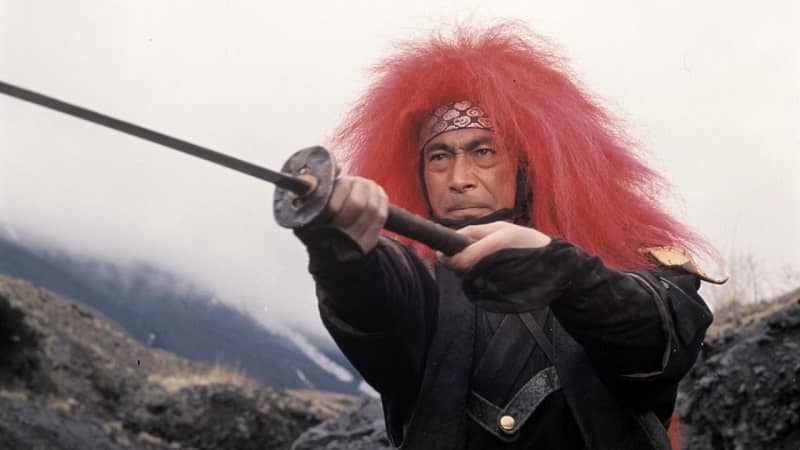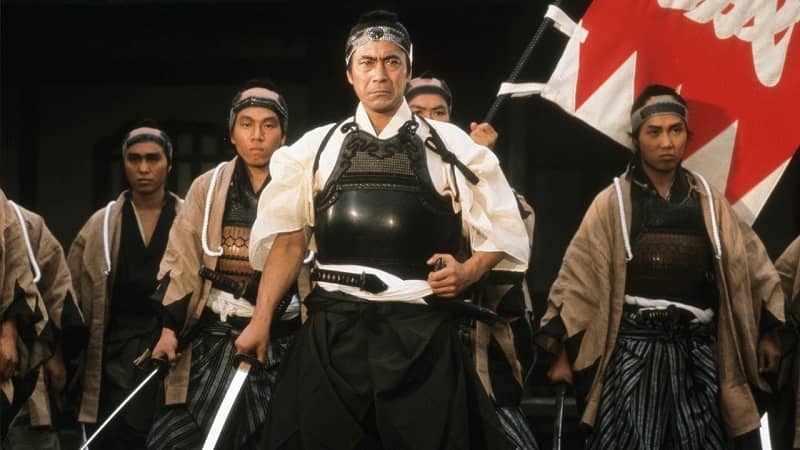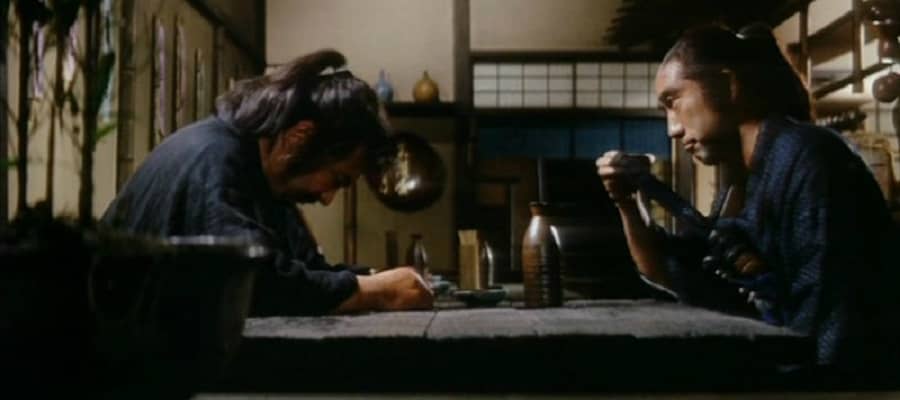Ellsworth’s Cinema of Swords: Shogunate’s End
Red Lion (Japan, 1969)
The Tokugawa Shogunate of the samurai military caste ruled Japan for over 300 years, keeping the island nation in a sort of stasis enforced by rigid regulation and an entrenched hierarchy. But outside, the rest of the world was changing, as the western powers of Europe and America developed economies based on global trade on terms backed up by military might. In 1853, when the United States came knocking on Japan’s door, insisting on trade concessions, the Shogunate had only swords and matchlock muskets with which to oppose armored warships, and had to comply with the American demands. Other western nations followed suit, and Japan began to open its borders, resulting in economic and political instability that the Shogunate was too weak and hidebound to manage successfully.
This period before the imperial restoration of 1868, known as Bakumatsu, was a sort of slow-burning civil war in which a number of factions struggled for ascendancy, all sides resorting to death squads and assassinations. The time of the sword, which had ruled Japan for almost a thousand years, was coming to an end.
Red Lion
Rating: ****
Origin: Japan, 1969
Director: Kihachi Okamoto
Source: Warrior DVD
Kihachi Okamoto, who directed the excellent chambara parody Kill!, returns with what seems to be, at first blush, an outright samurai comedy. It’s co-produced by and stars Toshiro Mifune, who we’ve seen can be slyly funny in movies such as Sanjuro, but here he plays a straight-up comic character, a warrior named Gonzo who’s as strong as he is dimwitted, speaks with an awkward stutter, and is emotional about everything. He’s brilliant.
It’s 1868, and the Tokugawa Shogunate is finally falling to the forces of the Imperial Restoration, starting in the capital of Edo, where crowds of commoners dance in delirious celebration, chanting, “It’s alright! It’s alright! Why not?” Gonzo is a soldier in the Sekiho Brigade, which supports the emperor’s restoration, and is known as the red lions for the shaggy scarlet helmet covers worn by their officers. The imperial troops are gradually spreading their revolution to rural Japan, and when Gonzo sees that they’re planning to march through his home village, he boldly requests permission to ride ahead and bring them the good news—and can he please borrow his captain’s red headpiece?
Gonzo, armed with leaflets proclaiming that land taxes will be halved and debts forgiven, rides for his village, where he finds that the old, corrupt ways of the Shogunate are still in force: the local deputy is extorting double taxes out of the peasants, the yakuza moneylender charges predatory rates, and families who can’t pay are coerced into selling their women into bondage at the brothel. With his news of a New World Order, Gonzo hits his hometown like a hurricane, encouraging the local young idealists to fight for the imperial cause, redistributing the stolen rice from the tax collector’s warehouse, and liberating the debt-ridden prostitutes from the brothel — one of whom is Tomi (Shima Iwashita), Gonzo’s childhood sweetheart.
The villagers are thrilled. But though the old bosses are intimidated by this stuttering force of nature, there are those who aren’t impressed. This includes ronin-for-hire Hanzo (Etsushi Takahashi), who accepts money from the bosses to kill Gonzo, and a secret cadre of Shogunate agents known as Mobile Unit One, who are waiting to assassinate the leaders of the advancing imperial forces.
And suddenly the story’s tone grows darker, as the agents and the bosses start to turn the villagers against Gonzo, playing on their fears and suspicions and hoodwinking the simple warrior. But Gonzo fights back, proving himself, and even sends some of the young idealists out to welcome the oncoming Sekiho Brigade and guide them into town.
But the young villagers ride into the imperial camp to find no red lions, only white lions — the Sekiho Brigade is no more, disbanded and its officers beheaded after being accused of overreaching and pandering to the peasants. Tax cuts and debt forgiveness are all repudiated, and it’s clear the new masters will be no better than the old ones, if not worse. The young villagers are shot down, all but one who rides, mortally wounded, back to town to warn Gonzo what’s coming.
A squad of imperial riflemen follow the rider back to the village, and though Gonzo, joined by Hanzo, cuts them down, he has no chance against an entire advancing army. Utterly betrayed, things can’t end well for Gonzo — but his legacy will live on, as he’s taught the villagers how powerful they can be if they all act together. “It’s alright! It’s alright! Why not?”
Shinsengumi: Assassins of Honor (or Band of Assassins)
Rating: ***
Origin: Japan, 1970
Director: Tadashi Sawashima
Source: Toho Video DVD
Just the year before, Toshiro Mifune had co-produced and starred in Samurai Banners, a historical epic about the beginning of the Tokugawa era; here he does the same in a film about the era’s end. In the 1860s Japan went through a civil war in which the samurai of the Shogunate, who wanted to continue running the country as they had for three centuries, were opposed by samurai who wanted change and supported a restoration of the power of the Emperor.
This film is about Isami Kondo (Mifune), who rose to command the Shinsengumi, a paramilitary force of former masterless samurai who banded together to help defend the Shogunate. Kondo, a poor country samurai who ran a sword training school, initially comes to the capital Kyoto when he hears there are threats to the Shogunate, the institution that to him represents all that was meaningful about the samurai tradition. He joins an early band opposed to the imperial “loyalists” run by the obstreperous Kamo Serizawa (Rentaro Mikuni) and quickly distinguishes himself, so when the group is reconstituted as the Shinsengumi, Kondo becomes one of the commanders.
As an unofficial arm of the Shogunate, it soon develops that the role of the Shinsengumi is to use spies and informers to identify adherents of the imperial faction and then murder them. At this the band is all too successful, and soon co-commander Serizawa becomes an embarrassment, killing and looting indiscriminately and spending the spoils on saké and women. Kondo tries to get Serizawa to reform, but eventually joins with the other commanders to assassinate him. After that, Kondo is the undisputed leader of the band.
This film takes no sides in the politics of the opposing factions, just observes the character of Kondo as he gradually grows sick of all the killing and realizes that it changes nothing. Kondo is a stoic, reserved and restrained, and Mifune is brilliant at conveying his thoughts and feelings through the tiniest changes of expression. Kondo’s world is harsh and brutal, but he’s convinced that if he maintains self-discipline and adheres to the warrior code, then surely by example he will lead his men to do what is right. But he’s only human, he makes mistakes, and even when he finally sees that the code of the samurai is no longer the solution to Japan’s problems, he stays true to it. Unfortunately, modern warfare has arrived, and bringing a katana to a gunfight doesn’t work out well for the Shinsengumi.
The swordplay in this film is realistic and brutal, as harsh and unforgiving as civil war usually is, especially when Kondo leads a raid on a clan planning an arson attack, arguably saving Kyoto from burning down. But the Shogunate is weak and failing, and though Kondo finally sees that his end is inevitable, he faces it forthrightly. Alas, inevitability doesn’t necessarily make for a compelling story, and in this case, it deflates the last act of the film. Mifune is great, and the depiction of Japan at the end of the Tokugawa era is excellent, but this movie won’t be for everybody.
Hitokiri (or Tenchu)
Rating: ****
Origin: Japan, 1969
Director: Hideo Gosha
Source: Fuji Telecasting DVD
It’s worth nothing up front that one of the stars of this film is Yukio Mishima, the celebrated Japanese writer, provocateur, public intellectual, and nationalist who tried (and failed) to inspire a right-wing coup d’état in Japan in 1970. By all accounts a thorough narcissist, it’s fascinating to see him here playing a character who’s strong, stoic, honorable, and ruthless, traits that align so closely with how Mishima saw himself. He definitely has a magnetic screen presence, though he appears in this film for less than five minutes all told, despite being fourth-billed behind Shintaro Katsu, Tatsuya Nakadai, and Yujiro Ishihara.
The story is set in 1862, a time of conflict between samurai clans supporting the failing Shogunate and those who want to restore power to the emperor. However, if you’re hoping to learn about the fascinating politics of that era, this isn’t the movie for you. This is a character study of one of the samurai who opposed the Shogunate, an angry and ignorant man named Okada (Katsu), who at the start of the film is at the end of his resources. The local pawn shop won’t even take his family suit of armor, and he’s all at sea until he’s taken up by Takechi (Nakadai, exuding cold megalomania), an officer of the Tosa clan who’s forming a death squad to murder the political enemies of the emperor.
Takechi praises Okada’s sword work, which though untutored is wild and effective, but since Okada’s never killed a man, Takechi sends him along to observe an assassination of a clan regent by three of his swordsmen. The murder is a slow horror in the pouring rain as Takechi’s men bungle the job; Okada, watching from the shadows, sneers, “Damn, I could do better than that. I could kill.”
And so he does: Okada quickly becomes the Tosas’ most feared killer, ritually crying out “Tenchu!” (“Heaven’s punishment!”) as he cuts men down with his extra-long katana. Okada is well paid for his murders and comes to see himself as a big man in the Tosa clan, respected and responsible for Takechi’s increasing influence. Only gradually, and with great reluctance, does he realize that Takechi, far from respecting him, regards him as nothing but a tool, a thing to be discarded when Okada becomes an embarrassment by drawing too much attention to himself.
Katsu is excellent as Okada, a man of low rank whose only skill is fighting, but whose character is otherwise opposite in every way to Katsu’s signature role of Zatoichi. When Okada is chastised by Takechi for not following orders, he angrily quits the Tosas and goes looking for another patron. He’s even befriended by his rival Shinbei (Mishima), the leading killer of the Satsuma clan, but no one will hire him. Eventually he goes crawling back to Takechi, who assigns Okada to kill a government official and frame Shinbei for the murder.
When Shinbei is presented with the evidence of his guilt, his own sword discovered at the crime scene, he draws the blade and instantly commits seppuku. This breaks Okada; he goes on a drunken binge, gets in a fight with a whole squad of police, and ends up in jail — and Takechi, to his horror, leaves him there. When he’s finally released, Okada is a changed man, but his relationship with Takechi must still be resolved.
This film is about twenty minutes too long, and while Hideo Gosha’s direction is as good as you’d expect, his eye when shooting in color isn’t as sharp as in black and white, and night scenes are often murky. But the performances of the leads are outstanding, and that alone makes this well worth watching.
One year after the release of “Hitokiri” — which means “killer” — Mishima’s attempted right-wing coup was a failure, and, like Shinbei, he committed seppuku with his own sword.
Where can I watch these movies? I’m glad you asked! Many movies and TV shows are available on disk in DVD or Blu-ray formats, but nowadays we live in a new world of streaming services, more every month it seems. However, it can be hard to find what content will stream in your location, since the market is evolving and global services are a patchwork quilt of rights and availability. I recommend JustWatch.com, a search engine that scans streaming services to find the title of your choice. Give it a try. And if you have a better alternative, let us know.
Previous installments in the Cinema of Swords include:
Flynn’s Last Flourishes
Mighty Colossi And Hydrae
Rejecting Bushido (Part One)
Pirates — Italian Style
The Year of Camelot and Scarecrows
Rejecting Bushido (Part Two)
The Fall of the Hollywood Epic
Cheh’s On Second
En Garde, Old Boy
More Hammer Historicals
Zatoichi’s Finest
A Little History
Lone Wolf and Cub, Part I
Premium Peplum
The Book Was Better
LAWRENCE ELLSWORTH is deep in his current mega-project, editing and translating new, contemporary English editions of all the works in Alexandre Dumas’s Musketeers Cycle, with the fifth volume, Between Two Kings, coming in July from Pegasus Books in the US and UK. His website is Swashbucklingadventure.net.
Ellsworth’s secret identity is game designer LAWRENCE SCHICK, who’s been designing role-playing games since the 1970s. He now lives in Dublin, Ireland, where he’s writing Dungeons & Dragons scenarios for Larian Studios’ Baldur’s Gate 3.



The Shinsengumi were are real organization that was either noble, defenders of the samurai tradition or a paramilitary hit squad depending on your point of view. The members appear a lot in Japanese pop culture such anime Rurouni Kenshin and Intrigue in the Bakumatsu. Kenshin is easy to find and was considered a classic, but its star has dimmed since its creator was arrested for having a kiddie porn collection. Intrigue is hard to find but was, for the most part, pretty good.
If you have Netflix, they’re currently running the last 2 movies in the 5 movie live action version of Rurouni Kenshin, “The Beginning” and “Final” here in the US. If you can find them, the first 3 movies in the series are fantastic adaptations with great sword fighting and action.
Definitely three great movies of the Bakumatsu period. This seems to be fertile ground for Japanese filmmakers to make great movies. There are so many great movies on the Shinsengumi and other aspects of the Bakumatsu, that you will be overwhelmed. A recent movie on the Shinsengumi that is great if you’re interested is “When the Last Sword is Drawn”, which is based on the alleged real exploits of 2 members of the Shinsengumi, Saito Hajime and Yoshimura Kanichiro. It won Japan’s Best movie, best actor, and best supporting actor awards in 2004. The movie is probably about 15 minutes too long, and suffers from the same problem that “Lord of the Rings: Return of the King” had with too many endings. Another great one is “Moeyo Ken” or “Burning Sword” which tells the story of Kondo’s second in command of the Shinsengumi, Hijikata Toshizo, the “Demon Commander” of the group. A remake is supposed to come out in Japan if it hasn’t already. I would also suggest, if you get a chance, to watch it, is the 2004 Taiga drama, “Shinsengumi!”. You will enjoy it as it tells the story of the group from Kondo and Hijikata’s beginnings to the end. It whitewashes the group to make them more relatable, but you get great acting, writing, and all of the historical events large and small that the group was involved with are in it as it runs around 48 hours (the Taiga is a weekly dramatic show that spends an entire year depicting the lives of famous people, events, or characters in Japanese history and legend. The 2003 one on Miyamoto Musashi can be found on Youtube in its entirety).
If you like “Hitokiri”, which is based on the most famous of the “4 Killers of the Bakumatsu”, Okada Izo, Matthew mentions the manga/anime character Rurouni Kenshin, who is also based on one of the 4 killers, and the 5 live action movies that have come out based on the Kenshin manga/anime in the last few years are fantastic!
Those movies look interesting.
For Asian films I’ve recently been following “Shadow” watching it repeatedly on Netflix – not so much the story as the perfect placement of art – and very inspiring as I’ve been exploring the Japanese/Chinese ink painting style. Like the Jet-Li “Hero” movie this has almost every scene perfectly placed as if it could be an epic illustrated story or careful woodblock print. The story itself in Shadow has two kingdoms based on Yin and Yang, light and dark – but because there are incompetent leaders, corrupt officials, heroes with changing ties and questioned honor it’s all shades of grey, everything blending together but overall a ‘black’ feel. This is versus “hero” that went the full brilliant color spectrum in combination with artistic placement.
I just hate Netflix blacks out and tries to sabotage screenshots – have wanted to play on my tablet so I could pause and practice ink painting.
Another Ellsworth’s Cinema of Swords? Most Excellent!
Of these three films, I have only seen part of Red Lion but they all sound like they’re worth a good, long look. Thanks for giving me a peek at two more films I might never have even glanced at.